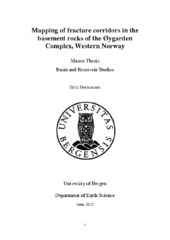| dc.description.abstract | Fracture corridors, defined as tabular zones of enhanced fracture intensity, are common features in both sedimentary and crystalline rocks. As potential high permeable structures, research has shown that fracture corridors have significant effect on fluid flow in subsurface reservoirs, e.g. by causing early water break through or compromise top seal integrity in hydrocarbon reservoirs. Yet, the mechanisms for their development, geometrical and fluid flow properties are poorly understood. With a growing interest in basement plays on the Norwegian continental shelf following the Rolvsnes hydrocarbon discovery, an improved knowledge of the intrinsic architecture of fracture corridors in basement rocks is valuable. By detailed outcrop mapping and digitization of fracture patterns in fracture corridors in the basement rocks of the Øygarden Complex on Sotra, SW Norway, this study aims to broaden the knowledge of the spatial distribution of fractures and topological parameters within fracture corridors. The methodology combines a characterisation of the geometric properties (fracture orientations, abundance, distribution) with topology, which characterise the spatial relationship between fractures. This enabled both geometric and fluid flow properties, such as the connectivity, of different types of fracture corridors to be quantified. Results show that the fracture intensity within fracture corridors are about three to six times higher than in the immediate surroundings. The fracture corridors mainly consist of sub-parallel fractures, resulting in a low to intermediate connectivity and an anisotropic flow direction. As the majority of fractures are not sealed by minerals of fault gouge, the abundance of fracture corridors observed onshore indicate that these features are significant also in the basement plays on the Norwegian Continental Shelf. This study has developed an extensive database of fracture attributes, which is utilized to investigate the spatial arrangement and possible models for the development of fracture corridors in the basement rocks on Sotra. This study has documented and quantified geometric and topological parameters based on fracture patterns observed in outcrops, and as basement plays are poorly constrained by seismic data, the spatial arrangement of fracture corridors found through this study can improve the understanding of fluid flow in basement reservoirs on the NCS. | en_US |

